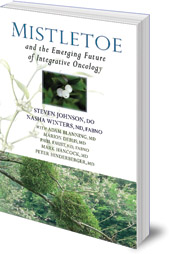Mistletoe and the Emerging Future of Integrative Oncology
Quick Look
- An introduction for medical professionals to the use of mistletoe therapy as a treatment for cancer
- Includes a guide explaining how both practitioners and patients and their loved ones can use this book
- Written by highly regarded experts in the fields of cancer care and research -- Steven Johnson, Nasha Winters, Adam Blanning, Marion Debus, Paul Faust, Mark Hancock and Peter Hinderberger
An introductory summary of core information for both practitioners looking to explore mistletoe therapy and anyone interested in learning about this alternative approach to treating cancer.
Description
Mistletoe therapy is becoming more recognised as a viable treatment for cancer. The mistletoe plant contains several compounds including lectins which improve immune defences and can decrease the negative effects of cancer treatments. As a therapy, mistletoe represents a rediscovery of ancient wisdom and shows us how the science of modern medicine might expand its reach and reconnect with a more human-centred medicine.
This book condenses the information shared at a three-day practitioner training course hosted by the Physicians' Association for Anthroposophic Medicine, highlighting several key lectures. This book serves as a bridge between conventional oncology and the development of Integrative Medicine as an effective path in the treatment of cancer.
This book is a valuable resource for medical practitioners who want to expand cancer treatment options for their patients, as well as informative background reading for anyone interested in alternative medicine.
Table of Contents
C O N T E N T S:
How to Use this Book
Foreword by Dr Luis A Diaz
Introduction by Dr Steven Johnson, DO
PART 1: THE LANDSCAPE OF MISTLETOE THERAPY
1. Ancient Plant, Modern Therapy:
A Brief History of Mistletoe and Modern Oncology
Dr Steven Johnson, DO and Dr Nasha Winters, ND, FABNO
2: The Immunology and Science of Mistletoe
Dr Paul Faust, ND
3: The State of Current Mistletoe Research
Dr Paul Faust, ND and Dr Marion Debus, MD
PART 2: MISTLETOE IN CLINICAL PRACTICE
4: Understanding Host Trees:
Best Practices in Choosing Mistletoe Therapies
Dr Peter Hinderberger, MD
5: Test, Assess, Address . . . Don’t Guess! Adjusting Treatment
Priorities in Response to the Patient's Unique Terrain
Dr Nasha Winters, ND, FABNO
PART 3: HUMAN-CENTERED MEDICINE
6: The Physiology of Warmth
Dr Adam Blanning, MD
7: What is 'Constitutional Care' in the Anthroposophic World?
Seeing the Whole person, the Whole Human Organism, before Providing Care
Dr Peter Hinderberger, MD
8: Pairing AM Adjuvants:
Helleborus and Other Anthroposophic Remedies Provided alongside Mistletoe Therapy
Dr Steven Johnson, DO
9: Building the Bridge between Mistletoe and
Other Integrative Therapies
Dr Nasha Winters, ND, FABNO
PART 4: WEAVING IT ALL TOGETHER: SPECIAL APPLICATIONS IN CLINICAL PRACTICE
10: Unique Scenarios: Novel Mistletoe Administration Routes and Understanding Tissue-origins of Specific Cancer Types
Dr Mark Hancock, MD and Dr. Marion Debus
11: Using Mistletoe Therapy in Advanced Disease and End-of-Life Care
Dr Steven Johnson, DO
12: What the Horizon Holds for Mistletoe Therapy . . . And for an Expanding Integrative Approach to Cancer Care
Dr Nasha Winters, ND, FABNO
Afterword by Holly Lucille, ND, RN
APPENDICES
A: Basics of Mistletoe Administration
B: Dramatic Responses to VAE Therapy
C: Anamnestic Form
D: MD Anderson Prognostic Scoring System
E: Host Trees and Cancer Types: Basic Matching Guidelines
F: Terrain-centric Core Lab Tests and True Healthy Ranges
Author
Nasha Winters is a global healthcare authority and best-selling author in integrative cancer care and research. She is currently planning for a comprehensive metabolic oncology hospital and research institute in the US. She lives in Colorado, USA.
Steven Johnson directed one of the first inpatient integrative medicine clinics in the US and now directs the first European Mistletoe/Integrative Medicine Training Program in North America. He lives in New York, USA.

